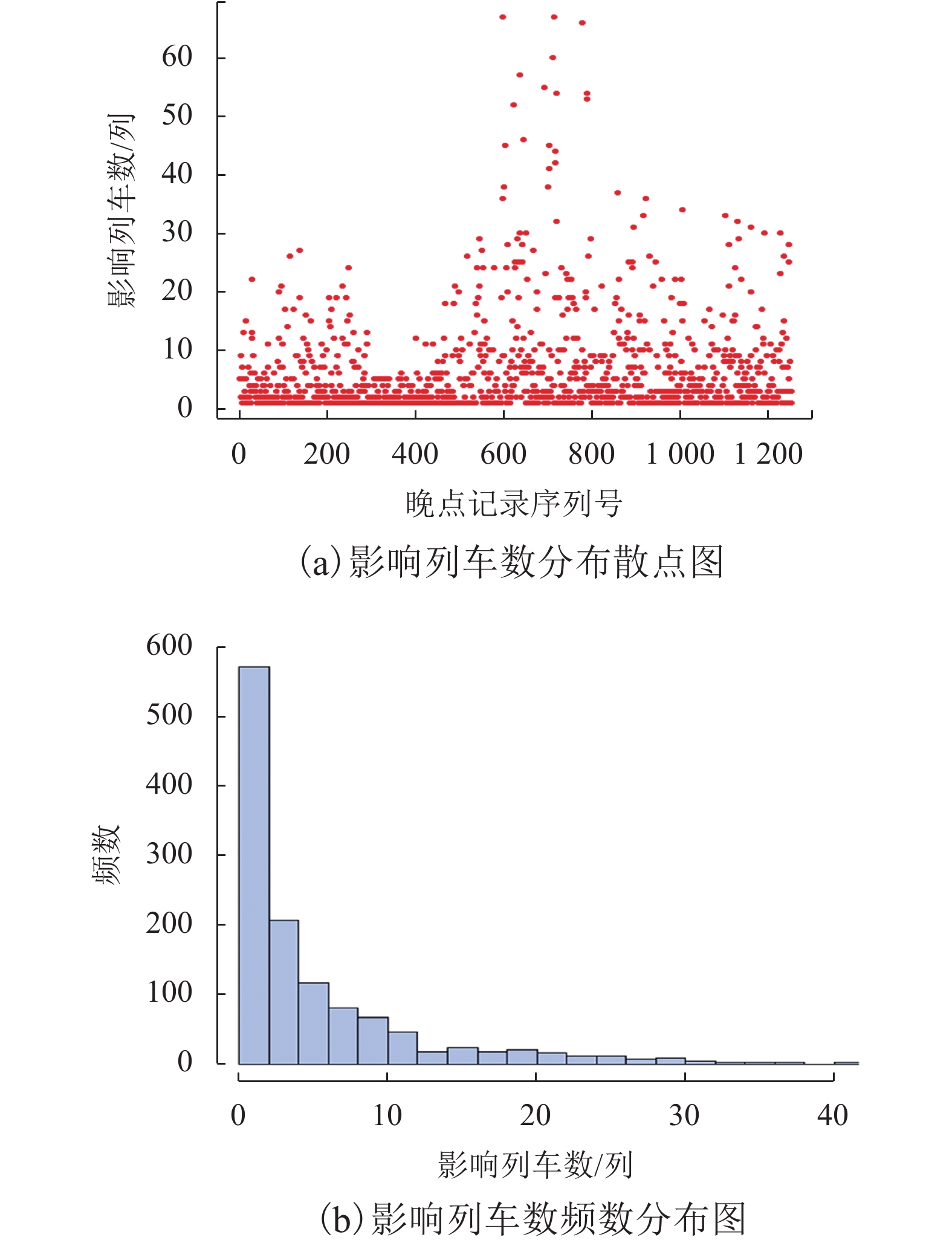Cause-based Distribution Models of Affected Trains Account for Primary Delay in High-Speed Rail
-
摘要: 为了研究高速铁路列车晚点严重程度,基于统计建模方法建立了高速铁路列车初始晚点不同致因情况下影响列车数的分布模型. 首先基于中国铁路广州局集团有限公司的高速铁路列车运行实绩,以2014年至2015年高速列车初始晚点影响列车数为建模数据,比选了5类备选模型对初始晚点影响列车数分布曲线的拟合优度;其次运用R语言估计了模型参数并建立了初始晚点致因-影响列车数分布的逆模型;最后对模型可行性进行了卡方检验,并运用2016年高速列车运行实绩数据进行Kolmogorov-Smirnov双样本检验. 研究结果表明:每类致因的逆模型精度都能够通过0.05的显著性水平检验,所建立的分布模型与校验数据是同分布,模型预测结果对初始晚点原因的实际影响列车数匹配度在97%以上.Abstract: To measure the severity of high-speed train delays, the distributions models of the affected trains, owing to different cause-based primary delays, were established using statistical modeling. First, the train operation records during 2014 and 2015 obtained from China Railway Guangzhou Group Co. Ltd. were considered to train the models, and the goodness of fit of the five candidate models was compared. Subsequently, the inverse regression model was used to model the distributions of the cause-based affected trains, and the parameters of the models were estimated using the R-program. Finally, the chi-square test was performed, and subsequently, the Kolmogorov-Smirnov double sample tests with respect to the models were employed based on the testing data of 2016. The test results indicate that all the cause-based models can pass the accuracy test under the significance level of 0.05, and the established models are identically distributed according to the testing data. The tests also indicate that the matching degree between the prediction results and the observations owing to the delay causes can be higher than 97%.
-
Key words:
- high-speed rail /
- train operation data /
- primary delay /
- number of influenced trains /
- inverse model
-
表 1 不同模型拟合优度
Table 1. The fitness of different models
晚点
致因线性
模型对数
模型逆模型 二次
模型三次
模型TD 0.246 0.616 0.996 0.482 0.657 FRS 0.402 0.749 0.986 0.676 0.845 FC 0.501 0.786 0.971 0.784 0.892 FT 0.513 0.813 0.967 0.800 0.898 FPSC 0.458 0.811 0.912 0.744 0.878 FW 0.380 0.758 0.866 0.658 0.801 FFM 0.457 0.803 0.946 0.755 0.855 FO 0.281 0.591 0.935 0.504 0.661 表 2 逆模型参数系数及检验
Table 2. Coefficients and test results of the inverse model
晚点
致因β1 β2 TD 0.310 6 –0.007 3 FRS 0.350 0 –0.013 4 FC 0.515 8 –0.049 3 FT 0.369 2 –0.015 9 FPSC 0.250 7 –0.001 4 FW 0.183 6 0.001 8 FFM 0.252 0 –0.000 9 FO 0.370 8 –0.016 2 表 3 初始晚点致因-影响列车数解释程度
Table 3. Explanation degree of each model of cause-affected trains
晚点致因 i Ki Zi Si Ei/% TD 1 24 1 249 1 193 95.5 FRS 2 24 259 257 99.2 FC 3 7 197 189 95.9 FT 4 17 84 84 100.0 FPSC 5 36 217 216 99.5 FW 6 67 201 201 100.0 FFM 7 32 156 155 99.3 FO 8 17 135 122 90.4 表 4 卡方检验结果
Table 4. Chi-square test results
晚点致因 p 是否通过检验 TD 0.255 9 是 FRS 0.297 4 是 FC 0.227 0 是 FT 0.307 6 是 FPSC 0.321 2 是 FW 0.385 1 是 FFM 0.329 2 是 FO 0.288 2 是 表 5 K-S检验结果
Table 5. K-S test results
晚点致因 建模样本量 检验样本量 p TD 1 249 904 0.279 FRS 259 198 0.155 FC 197 119 0.059 FT 84 55 0.172 FPSC 217 315 0.084 FW 201 43 0.001 FFM 156 116 0.569 FO 135 63 0.000 -
彭其渊,李建光,杨宇翔,等. 高速铁路建设对我国铁路运输的影响[J]. 西南交通大学学报,2016,51(3): 525-533PENG Qiyuan, LI Jianguang, YANG Yuxiang, et al.Influences of high-speed railway construction on railway transportation of China[J]. Journal of Southwest Jiaotong University, 2016, 51(3): 525-533 YUAN J, GOVERDE R M P, HANSEN J A. Evaluating stochastic train process time distribution models on the basis of empirical detection data[J]. Comprail, 2006, 88: 631-640 孙焰,刘胤宏,李致中,等. 列车运行图的晚点概率分析[J]. 长沙铁道学院学报,1998(4): 83-89SUN Yan, LIU Yinhong, LI Zhizhong, et al. The analysus of delying time probablity for the travelling graph of trains[J]. Journal of Changsha Railway University, 1998(4): 83-89 CUI Y, MARTIN U, ZHAO W. Calibration of disturbance parameters in railway operational simulation based on reinforcement learning[J]. Journal of Rail Transport Planning & Management, 2016, 6(1): 1-12 NILS O E O, HANS H. Influencing factors on train punctuality results from some Norwegian studies[J]. Transport Policy, 2004, 11(4): 387-397 MICHIEL V. Reliability of Railway Systems[D]. Rotterdam: Erasmus University Rotterdam. 2005 BRIGGS K, BECK C. Modelling train delays with q-exponential functions[J]. Physica A:Statistical Mechanics and its Applications, 2007, 378(2): 498-504 KRÜGER N, VIERTH I, FAKHRAEI R F. Spatial, temporal and size distribution of freight train delays: evidence from Sweden[R]. Stockholm, Sweden: CTS-Centre for Transport Studies Stockholm (KTH and VTI), 2013 WALLANDER J, MAKITALO M. Data mining in rail transport delay chain analysis[J]. International Journal of Shipping and Transport Logistics, 2012, 4(3): 269-285 李兰波. 提高旅客列车正点率的理性认识[J]. 中国铁路,2002(3): 26-28LI Lanbo. Rational knowledge of boosting the punctuality of passenger trains[J]. Chinese Railways, 2002(3): 26-28 刘岩,郭竞文,罗常津,等. 列车运行实绩大数据分析及应用前景展望[J]. 中国铁路,2015(6): 70-73LIU Yan, GUO Jingwen, LUO Changjin, et al. Big data analyzing and application prospect expectation of train operation records[J]. Chinese Railways, 2015(6): 70-73 彭其渊,朱松年,闫海峰. 列车运行图可调整度评价系统研究[J]. 西南交通大学学报,1998,33(4): 367-371PENG Qiyuan, ZHU Songnian, YAN Haifeng. A system for evaluation of train diagram elasticity[J]. Journal of Southwest Jiaotong University, 1998, 33(4): 367-371 XU Peijuan, CORMAN F, PENG Qiyuan. Analyzing railway disruptions and their impact on delayed traffic in Chinese high-speed railway[J]. IFAC Papers On Line, 2016, 49(3): 84-89 庄河,文超,李忠灿,等. 基于高速列车运行实绩的致因-初始晚点时长分布模型[J]. 铁道学报,2017,39(9): 25-31ZHUANG He, WEN Chao, LI Zhongcan, et al. Cause based primary delay distribution models of high-speed trains on account of operation records[J]. Journal of the China Railway Society, 2017, 39(9): 25-31 WEN Chao, LI Zhongcan, LESSAN J, et al. Statistical investigation on train primary delay based on real records:evidence from Wuhan–Guangzhou HSR[J]. International Journal of Rail Transportation, 2017, 5(5): 170-189 张文彤, 闫洁. SPSS 统计分析基础教程[M]. 2版. 北京: 高等教育出版社, 2011: 366-370 -






 下载:
下载:




